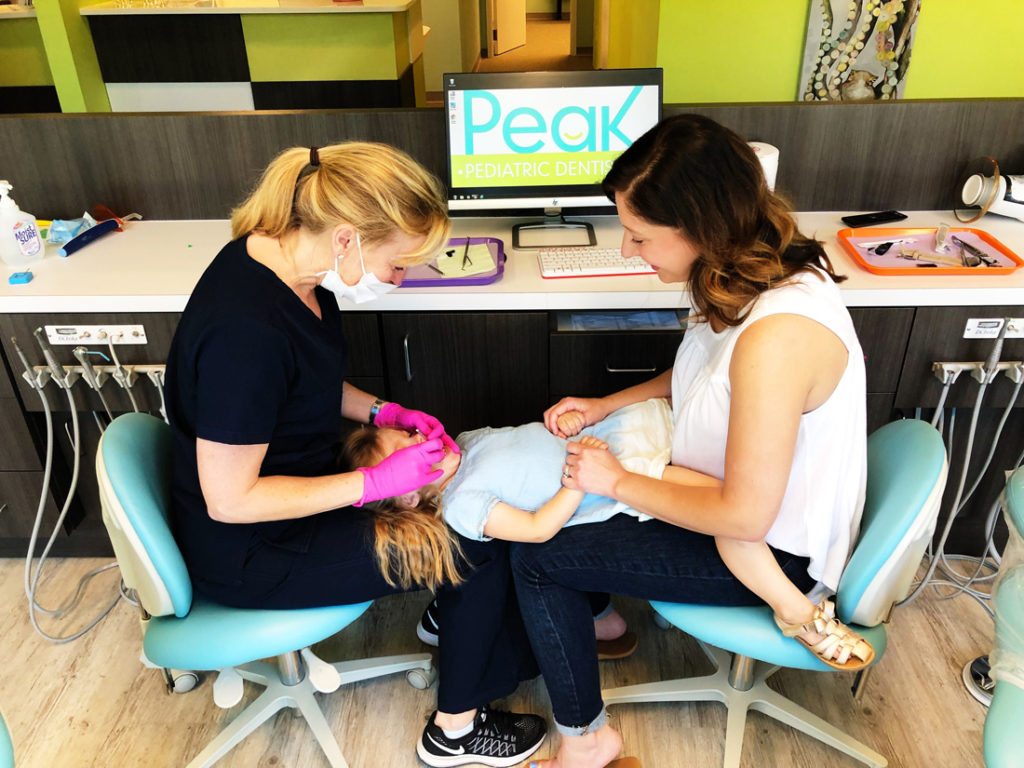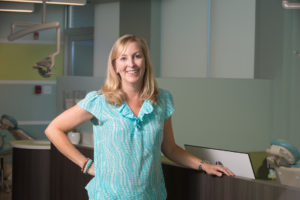BECOME MORE KNOWLEDGEABLE ABOUT YOUR KIDS’ DENTAL MILESTONES

Creating a positive experience with dental hygiene is an important part of your role as a caregiver. And yes, that often involves convincing your child to do or let you do something that they don’t want to do—like brushing, flossing or visiting the dentist. Dr. Aimee Cassinelli of Peak Pediatric Dentistry in Sandy Springs calls this process “magical” and enjoys helping shape kids’ dental experiences. “Pediatric dentistry has a lot of personality. It is all about talking to kids and parents, and having fun. We can shape their experience and create a positive lifelong dental experience,” she says, and notes that pediatric dentists have two additional years of training that includes behavior management. Here, Cassinelli weighs in on what to do, and when, to keep those little smiles in tip-top shape.
First Tooth
It may seem silly to brush your child’s teeth when she only has two. However, regular brushing should begin as soon as the first tooth pops up. “To start, parents can just use water and a washcloth. It’s really the mechanical act of brushing that’s most important early on,” says Cassinelli. It is a good idea to switch to a regular toothbrush when your baby’s molars erupt. When selecting a brush, a smaller, kids’ size brush with soft bristles is best. You can show your child how to use it, but make sure to brush after them to hit all the surfaces. “A good rule of thumb is to brush your children’s teeth for them until they have the dexterity to tie their own shoelaces, around third grade,” Cassinelli advises.

First Dentist Visit
The American Academy of Pediatric Dentistry (AAPD) recommends that your child see a dentist within six months of the eruption of his or her first tooth or by their first birthday, whichever happens first. “The first visit is to establish the ‘dental home’ and includes a lot of education for parents,” explains Cassinelli. “We’ll cover everything you need to know, including things like what to do when your kids fall and bump their teeth.”
Having trouble envisioning how your rambunctious 1- or 2-year-old is going to sit still in the dentist’s chair for an exam? Cassinelli says she often examines a child while they are lying in the parent’s lap. “The chair is the most intimidating part of the visit. I don’t even put a little one in it. We take our time, show them everything we’re going to do and, truthfully, if they begin to scream, it’s easier to examine their teeth!”
Losing Baby Teeth
Kids start losing their baby teeth around age 5 or 6. “We want your child to visit their dentist every 6 months, just as adults do. When children start ‘exchanging’ teeth— getting permanent teeth—seeing the dentist regularly is really important to watch the growth and development of the permanent teeth and jaws,” says Cassinelli. As for flossing, parents should floss their children’s teeth each day after brushing if their teeth are close together and touching. Flossing takes better dexterity than brushing, so children really need help with flossing until at least third grade.
Permanent Teeth
In many children do not need to see an orthodontist until all of their permanent teeth have developed, usually around age 12. “Your child’s dentist will watch your child’s tooth and jaw development and let you know when it is time to see an orthodontist,” Cassinelli explains.
PACIFIER VS. THUMB
Parents are often reluctant to give babies pacifiers because they may lead to crooked teeth or “nipple confusion,” but Cassinelli says it’s better than thumb sucking. Just make sure to choose an orthodontic pacifier that has a narrow base, such as those from Nuk, and avoid the ones with a stuffed animal attached, which can add weight and harm the teeth.
PEAK PEDIATRIC DENTISTRY
6095 Barfield Road, Suite 150
Sandy Springs 30328
770.274.4428
peakatlanta.com
Managing Editor and Wellness Columnist at Simply Buckhead. Blogger at Badass + Healthy.











